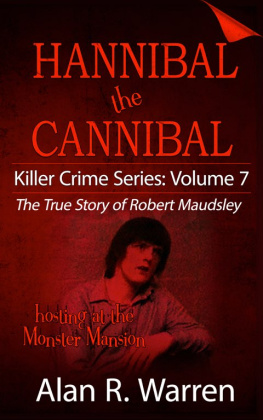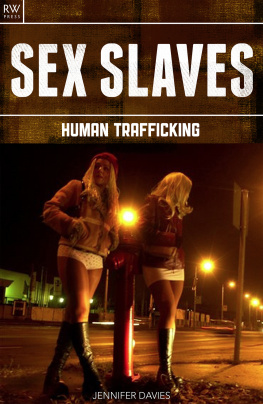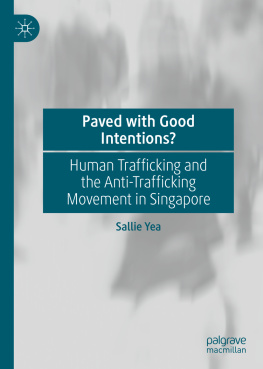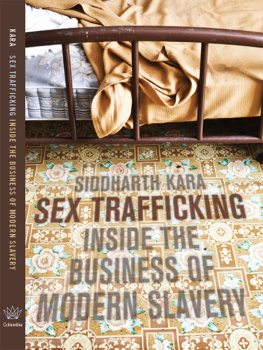I could not have written this book without the remarkable survivors who trusted me enough to open their lives to me, even in their most difficult circumstances. They were my heroes before writing this book and they still are people I think of on a daily basiseven Jennifer Kempton, whose courage and lucidity will go a long way to make us all understand how one can fall prey to traffickers.
The reason why I started this book was the pressing need I felt to shed light on this abominable crime; I wanted to make it easy to understand and to raise awareness so that fewer innocent people become victims. I hope it will reach a young public.
I could not have written this book without the fantastic help of Wylie OSullivan, who was my attentive, sensitive, and very demanding editor.
I also want to thank my fantastic team at the Thomson Reuters Foundation and especially Antonio Zappulla, my number two, for their unwavering support.
And of course, I am deeply grateful to the many specialists on the issue who spent so much time answering my questions and explaining to me obscure aspects of the trade that I found difficult to understandin no particular order: Kevin Bales, Cornelius Katona, Evelyn Chumbow, Cyrus Vance, Kailash Satyarthi, Sumedha Satyarthi, Alpana Rawat, David Batstone, Martina Vandenberg, Kevin Hyland, Ben Skinner, Jessica Graham, Mary Fisher, Barry Koch, Aditi Wanchoo, Giles Bolton, Nick Grono, Karen Friedman Agnifilo, Carolina Holderness, Manan Ansari, Minh Dang, Lu, Chen Guangcheng, Ajeet Singh, Sunita Danuwar, and Cecilia Flores-Oebandaand, of course, Anish Kapoor, for his passionate and long-lasting support.
I worked on this book during my holidays and weekends in 2017 and the first half of 2018, and I had the extraordinary privilege to be a resident at the Rockefeller Foundation villa in Bellagio to finish it in ideal conditions. My heartfelt thanks go to Pilar Palacia and her teamand to Raj Shah, for keeping this place like a paradise for authors and all kinds of academics and artists.
So who are the modern slaves? They are not chained as they were in the past. They can walk among us. For example, we can end up tipping one at a respectable hotel without knowing his or her circumstances; we wear dresses and accessories one has made; we can even be seated on a plane next to one. They look like us, although they inhabit a totally different universe.
The definition accepted by the best experts is that a slave is someone who is forced to work, through fraud or threat of violence, for no pay beyond subsistence. The biggest difference between ancient slavery and its modern form is that the former was almost always for life, whereas now slaves are more likely to be trapped for a few years, or even a few months, before being thrown away. In this era of mass consumption, slaves are only as good and valuable as their abilities. Once they are no longer usefulfor example, if they have become ill or injured while workingthey are discarded and abandoned to a twilight zone that can be as cruel and damaging as slavery itself.
Slavery is a flourishing global business today. Never in the history of human beings have there been so many slaves. Estimates vary, but there could be more than one hundred million adults and children enslaved across the world today. It is a vast, hidden, and perpetually evolving horror, and it is a difficult area on which to gather definitive data.
In 2017, conservative statistics from the International Labor Organization (ILO) and the Walk Free Foundation put the number at 40.3 million slaves worldwide. If slavery were a country or a state, it would have the population of Algeria or California. This figure of 40.3 million is based on available data, but most experts agree that the number is actually far higher. Unfortunately, in the absence of better information, it is the best we have at this point, and it is at least closer to the truth than the ILOs previous estimate of 20.9 million. But the lack of accurate data is a real and ongoing challenge when it comes to tackling the problem.
The best specialists estimate that 30 percent of slaves are trafficked for sex and 70 percent are in forced labor, though of course the ratio varies from country to country. So far, forced labor remains even less visible that sex trafficking, which has in recent years received media and government attention. Prosecutors are increasingly pursuing sex-trafficking cases in some countries, whereas they have a much harder time bringing forced-labor cases to court.
A big part of the problem is that people simply dont understand forced laborthat it exists in the supply chains of many of the brands we buy and in the service industries such as car washes, nail salons, and hotels, in every country. Prosecutors have to prove that traffickers have used fraud, coercion, or the threat of violence to induce someone to work and that they are not paying the person above subsistence.
This is why prosecutors often find it easier to pursue traffickers for money laundering or tax fraud than for trafficking. As the penalties are more or less the same, they go for the easier offense. The problem is that this approach doesnt help assemble reliable data.
Getting the figures right is crucialso that governments, corporations, the media, and the general public understand the true scope of this horror and where and how to combat it. Accurate data would also allow us to determine if we are making progress or if things are getting worse.
Kailash Satyarthi, the Peace Nobel Prize laureate who has saved thousands of children from slavery in India and runs two ashrams where he looks after survivors, recently told me that he believes there could be as many as 30 million children enslaved in India todaydramatically higher than official estimates. His team thinks the number could be even greater. If that is the number of children forced to work as slaves in India, imagine the number of adults trapped in the same condition. With a population of 1.3 billion people, the country is home to the largest number of enslaved people, followed by China.
Unfortunately, slavery can flourish easily because circumstances favor the exploiters and work against the victims. Slavery is an invisible and silent crime.
Slaves cannot shout for help because they are abused, beaten, and sometimes tortured into submission. I have seen more survivors than I can count scarred by cigarette burns and other unspeakable forms of branding. Ill never forget the fifteen-year-old Indian boy at Kailashs ashram who told me that in the New Delhi sweatshop where he was exploited, his masters favorite form of punishment was to fasten a child to a fan and watch it spin him around to guarantee that he remained obedient. The cruelty deployed to keep people in that state is unimaginable.
Very often, slaves dont even know that they have been enslaved. All the children I spoke to during my visit to Kailashs ashram in Rajasthan in May 2017 had believed that their parents were being paid for their work and that they were helping their families survive. It was not the case.
If they are fortunate enough to escape the hell of slavery, survivors risk finding themselves in another kind of hell. After years of abuse, they have lost their dignity, their self-respect, and their ability to trust anybody. They are incredibly vulnerable and the risk is that they will soon be re-trafficked if they dont receive adequate help. Starting a new life beyond slavery is challenging, even if the enslavement has been for a relatively short period. Many survivors can only start to find comfort when they spend time with other former slaves. These are the people they can relate to and begin to trust.
The road to full freedom is a very long and painful one, and much psychological work is required to try to rebuild so many shattered souls. Unfortunately, there are not many psychologists around the world who understand the very particular needs of survivors. Those who do have experience treating human-trafficking victims explain that survivors continue to be vulnerable to exactly the same things that have happened to them before.








